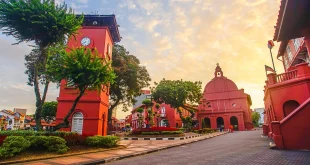Introduction to Romanian and Malaysian Cuisines
Step into the tantalizing world of Romanian and Malaysian cuisines, where centuries-old traditions meet modern flavors in a culinary showdown like no other. From the hearty dishes of Transylvania to the vibrant street food of Kuala Lumpur, get ready to embark on a gastronomic journey that will leave your taste buds craving more. In 2024, which cuisine will emerge victorious as the ultimate palate pleaser? Let’s dive in and find out!
Ingredients and Flavors Used in Romanian Recipes
Romanian cuisine is a delightful blend of flavors and ingredients that reflect the country’s rich history and cultural influences. One staple in Romanian recipes is pork, used in various forms such as sausages or stews. Another key ingredient is sour cream, adding a creamy texture to many dishes.
Cabbage is frequently used in Romanian cooking, often stuffed with a mixture of meat and rice for a hearty meal. Eggplant is another favorite vegetable, commonly roasted or grilled for added depth of flavor. Fresh herbs like dill and parsley are also prevalent in Romanian dishes, lending a bright and aromatic touch.
When it comes to spices, paprika features prominently in many recipes, adding warmth and color to the dish. Garlic is another essential element, providing a robust flavor profile. Vinegar or lemon juice are often used to add acidity and balance to savory dishes.
Romanian cuisine encompasses a diverse range of ingredients that come together harmoniously to create deliciously satisfying meals.
Ingredients and Flavors Used in Malaysian Recipes
Malaysian cuisine is a vibrant tapestry of flavors, drawing inspiration from various cultures such as Malay, Chinese, Indian, and indigenous traditions. One of the key ingredients that define Malaysian dishes is lemongrass – adding a citrusy and aromatic touch to many recipes. Coconut milk is another staple, lending a creamy richness to curries and desserts alike.
Spices play a crucial role in Malaysian cooking; turmeric for its earthy flavor and vibrant color, galangal for its pungent aroma, and belacan (shrimp paste) for its unique umami depth. The combination of these spices creates complex layers of taste that are both bold and harmonious.
Chili peppers are also ubiquitous in Malaysian cuisine, providing heat levels ranging from mild to fiery. Tamarind adds a tangy kick while pandan leaves infuse dishes with their sweet fragrance. The balance of sweet, sour, salty, and spicy flavors is what makes Malaysian food so irresistible.
Comparison of Traditional Dishes from Both Countries
Romanian cuisine boasts hearty dishes like sarmale, cabbage rolls stuffed with a mix of meats and rice, while Malaysian food offers the iconic nasi lemak, fragrant coconut rice served with anchovies, peanuts, and spicy sambal. The contrasting flavors of these traditional dishes represent the diverse culinary landscapes of each country.
In Romania, mămăligă is a staple – a creamy cornmeal porridge often paired with cheese or sour cream, providing a comforting taste reminiscent of home-cooked meals. On the other hand, Malaysia’s laksa captivates with its rich and complex broth infused with spices and coconut milk to create a symphony of flavors in every spoonful.
The juxtaposition between Romanian stews simmered for hours to achieve depth in taste and Malaysian stir-fried noodles cooked quickly over high heat showcases the unique cooking techniques prevalent in both regions. Each bite tells stories of generations preserving their heritage through time-honored recipes that continue to delight palates worldwide.
Fusion Recipes: Blending Romanian and Malaysian flavors
Exploring the culinary world often leads to unexpected and delightful combinations. When we think of blending Romanian and Malaysian flavors, a fusion of two rich cuisines emerges. Imagine the savory notes of Malaysian spices intertwining with the hearty ingredients found in traditional Romanian dishes.
In this culinary adventure, picture savoring a dish that marries the smoky aroma of Romanian grilled meats with the bold flavors of Malaysian curries. Perhaps a twist on a classic Romanian cabbage roll filled with fragrant Malay herbs and spices could create an entirely new gastronomic experience.
The unique textures and tastes from both cultures harmonizing on your plate would undoubtedly transport your taste buds to uncharted territories. Fusion recipes are not just about mixing ingredients; they are about celebrating diversity and creativity in the kitchen.
As you experiment with blending Romanian and Malaysian flavors, remember that there are no limits to what can be achieved when cultural influences collide in a delicious harmony.
Cultural Significance of Food in Romania and Malaysia
Romanian cuisine reflects the country’s rich history and diverse influences, blending flavors from Eastern Europe, the Balkans, and Turkey. Food is a central part of Romanian culture, with traditional dishes like sarmale (cabbage rolls) and mămăligă (polenta) often enjoyed during celebrations and gatherings.
In Malaysia, food plays a vital role in bringing people together. The country’s culinary scene is a melting pot of Malay, Chinese, Indian, and indigenous influences. Malaysian street food is legendary for its bold flavors and unique combinations like nasi lemak (coconut rice) or roti canai (flaky flatbread).
Both Romania and Malaysia view food as more than just sustenance; it’s a way to connect with others, celebrate traditions, and showcase their cultural heritage. From elaborate feasts to humble street stalls, the love for good food runs deep in both countries.
Conclusion
As we look ahead to 2024, it’s exciting to see the culinary landscape evolving with new trends and flavors. Romanian recipes bring a rich history and comforting ingredients, while Malaysian cuisine offers a vibrant mix of spices and aromas.
While both cuisines have their unique characteristics and loyal followers, it’s challenging to predict which one will reign supreme in 2024. With the growing popularity of fusion foods blending Romanian and Malaysian flavors, we might see a new wave of innovative dishes captivating food enthusiasts worldwide.
Whether you prefer the hearty stews of Romania or the bold flavors of Malaysia, both cuisines have something special to offer. So why not embark on a culinary journey exploring the best of both worlds? After all, good food knows no boundaries!


